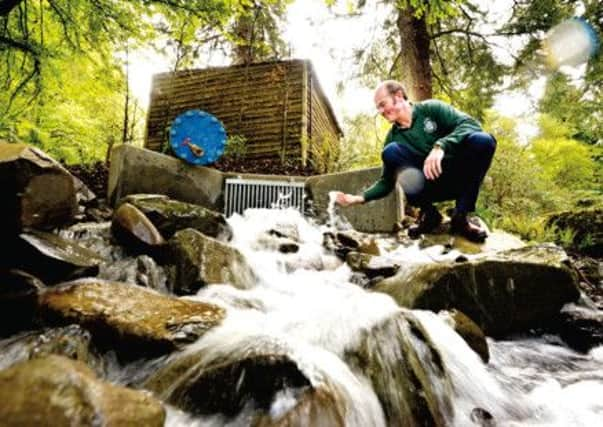Landmark micro hydro power scheme reintroduced


The pioneering Victorian scheme has been reinvented for the 21st century using the latest renewable technology and has helped a botanical garden near Peebles become the greenest in the UK.
It is the latest in a raft of eco-friendly innovations that have seen Dawyck, the Borders outpost of the Royal Botanic Garden Edinburgh (RBGE), being crowned as the first carbon-neutral garden of its type in the country.
Advertisement
Hide AdAdvertisement
Hide AdHeating for its visitor centre, which was built in 2008, is provided by a sustainable biomass boiler, while the revamped hydro system is forecast to offset more than 20 tonnes of climate-warming carbon dioxide each year.
New pipework has been installed to hook up with the garden’s 100-year-old Dynamo Pond, which was part of the original power supply for Dawyck estate and one of the earliest private hydro schemes north of the Border.
Modern micro hydro technology will use the natural flow of water from the Scrape Burn, a tributary of the Tweed that runs through the grounds, to generate up to 12 kilowatts of clean energy – enough to power both the visitor centre and the rest of the garden’s infrastructure, or the equivalent of around eight houses.
The new eco-friendly turbine house is clad in wood and topped with a sedum roof, in keeping with the one on the visitor centre, which provides insulation. The original system was in operation from the early 1900s until 1953. But by 1978, when RBGE took over the garden, electricity was supplied by the national grid and the disused turbine house had been torn down.
However, it was from this green tradition that the new plan has grown.
“Having looked to the practicalities of electricity generation on the site in Victorian times, we saw no reason not to reuse those lessons from the past alongside modern technology to create a sustainable future for the garden,” said Simon Milne, regius keeper of RBGE.
“As a result, we now have both heat and electricity generated from greener resources, and we are thrilled by the prospect of Dawyck being the first carbon-neutral botanic garden in the UK.”
Surplus energy from the scheme, which was funded by a £30,000 grant from EDF Energy’s Green Fund, will be sold back to the grid at times of low demand through the feed-in tariff. This offers a useful new income for Dawyck, which is run by the RBGE charity.
Advertisement
Hide AdAdvertisement
Hide AdAlthough a few specimens have been lost over the years, Dawyck is still home to many great conifers. These include its oldest tree, a European silver fir planted in 1680, a European larch from 1725 and a Douglas fir that stands at more than 50 metres tall. This added an extra complication during construction.
Nick Forrest, managing director of renewables firm Babyhydro, was responsible for building the new scheme.
He said being able to incorporate parts of the Victorian workings had made the job slightly easier and minimised harm to irreplaceable ancient plants.
“There had to be lots of hand-digging. Being a botanic garden, the number one concern was making sure the trees didn’t get damaged and the aesthetics didn’t get affected,” he said.
“We did find some of the old fireclay pipework and were able to use that a little bit in order to sneak past some of the roots of the bigger, older trees.”
The hydro scheme adds to the garden’s growing portfolio of green initiatives at Dawyck, which include recycling, composting and water-saving measures. Future plans include reusing rainwater.
Graham Stewart, the garden’s curator, said: “As a botanic garden, a place to enjoy the wonder that nature has to offer, we should strive to operate in a way which preserves the beauty of the planet for future generations.
“We are proud to have become the first carbon-neutral botanic garden in the UK and a shop window of how a botanic garden tourist attraction can operate with careful consideration to our impact on the environment.”
Advertisement
Hide AdAdvertisement
Hide AdJoss Blamire, senior policy manager at industry body Scottish Renewables, welcomed the move.
“Hydro schemes have provided power in Scotland for more than 100 years, and new developments are now bringing benefits to businesses and organisations across the country,” he said.
“Hydro, particularly with Scotland’s rainfall, is a reliable source of electricity that boosts a company’s green credentials, offsets the cost of rising energy bills and even has the potential to generate added revenue.
“It is particularly heartening that an organisation like the Royal Botanic Garden Edinburgh has chosen to invest in hydro technology – an original feature of the Dawyck site when it was built by the Victorians.
“Hopefully this new development will show visitors how successful hydro still is today and raise awareness of the benefits of renewable energy for our environment and economy.”
Now, after weeks of painstaking hand-digging around roots that have lain undisturbed for hundreds of years, the new scheme will be unveiled tomorrow by Scottish energy minister Fergus Ewing.